Radioman Second Class Julius Heinrich (Henry) Otto Pieper

- Unit: LST-523
- Service Number: 6488523
- Date of Birth: May 17, 1925
- Entered the Military: February 17, 1943
- Date of Death: June 19, 1944
- Hometown: Creston, Nebraska
- Place of Death: English Channel, off the coast of Normandy, France
- Award(s): Purple Heart
- Cemetery: Plot E, Row 25, Grave 43. Normandy American Cemetery, Colleville-sur-Mer, France
Mentored by Mrs. Nichole Flynn
Ainsworth High School
2014-2015
Early Life
Ludwig Julius Wilhelm Pieper (known as Louie) was born on May 17, 1925, in Esmond, South Dakota. He had an identical twin brother, Julius Heinrich Otto Pieper (known as Henry).
His parents, Otto and Anna Pieper were German immigrants. The twins had four siblings: Fred, their older brother, Ivona and Leona, their younger twin sisters, and Mary Ann, their youngest sister.
The family moved to Creston, Nebraska, when the twins were eight or nine years old. In Creston, Henry, Louie, and their siblings attended the local public school, and their family became members of St. Peter’s Lutheran Church.
Even from an early age, Henry and Louie did everything together. They graduated from Creston High School in 1942, becoming the first twins to graduate from the school. They worked for the Burlington Railroad out of Lincoln, Nebraska, in the winter of 1942-1943.

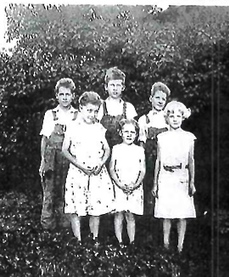
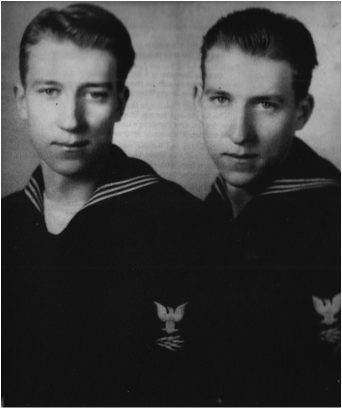
Homefront
Nebraska in World War II
During World War II, Nebraska dropped everything to contribute to the war effort. Naval ammunition depots, bomber plants, U.S. Army air bases, and scrap metal drives sprang up all over the U.S., including in Nebraska. But, Nebraska was also home to some outstanding wartime efforts, like the North Platte Canteen. Coming directly out of the Great Depression, wartime production revived Nebraska and the United States’ economies. The war not only changed the people and lands across the ocean, but it also changed America, right on the homefront.
Hastings Naval Ammunition Depot
In July 1942, the United States constructed its largest Naval Ammunition Depot (NAD) in Hastings, Nebraska. This 48,000-acre facility sent its first shipment of ammunition on July 4, 1943. The depot was located out of the range of German and Japanese aircraft, had an abundant supply of natural water, and could ship supplies by railroad to either coast in just two days. The NAD offered competitive wages, and in only three years, the population of this small Nebraska town nearly doubled. At one point during the war, it was calculated that 40% of the U.S. Navy’s ammunition came from the Hastings depot.
Martin Bomber Plant
The Glenn L. Martin Company assembly plant near Omaha was an essential part of Nebraska’s contribution to the wartime effort. By the end of the war, this plant had produced over 1,500 B-26 Marauder medium bombers and more than 500 B-29 Superfortress Bombers. The plant needed a massive number of workers. Relatively high pay and patriotic duty called many recent high school graduates and workers in low-paying jobs to come and help. These workers totaled almost 13,217 people, including women and African Americans.
Army Air Bases
Even before the declaration of war, President Franklin D. Roosevelt was looking to Midwestern states as possible Army air base locations. The coasts were vulnerable to air attacks, causing the area between the Appalachian and the Rocky Mountains to be the primary location for new bases. Nebraska was favored because of its excellent year-round flying conditions and sparsely populated areas. Before the war’s end, 12 U.S. Army air bases or satellite airfields were located in Nebraska, including one in my hometown of Ainsworth.
Scrap Metal Drive
The general American public was ready to do anything to help their boys overseas, and Nebraska was no exception. Nebraska got caught up in the patriotic enthusiasm that came with scrap metal drives, saving tin foil from gum wrappers, old nails, and anything else that they could deem even remotely metal. In a 1942 scrap metal drive, Nebraskans proudly noted that they had filled 111% of their quota and had finished fourteenth in the country. Even U.S. currency contributed to the drives. Copper went to war, and new zinc-coated steel pennies were issued in 1943.
North Platte Canteen
Bringing together Nebraskans from over 125 different communities and serving over six million troops during World War II, the North Platte Canteen was a volunteer effort of colossal proportions. On December 17, 1941, the families of the local Nebraska National Guard Company D gathered on the train platform to give the boys their Christmas presents. But as the train arrived and parents and spouses anxiously scanned the cars for their boys, they realized that Company D had come, but it was from the Kansas National Guard.
One person stepped forward and gave their presents to those troops instead, sparking an idea that carried on for the rest of the war. By December 25, the idea spread. A local group of women was waiting with goodies for the troops coming in on the train. A canteen was set up in an empty storefront across from the depot. For the rest of the war, women from communities all over Nebraska donated their time and extra ration stamps to make baskets full of goodies for every troop train that stopped in North Platte. As the war escalated, as many as 24 trains stopped in North Platte every day. The heavy traffic meant that a continual stream of workers was needed. By the time the Canteen closed at the end of the war, more than 55,000 volunteers, some from communities over 200 miles away, contributed to the North Platte Canteen.

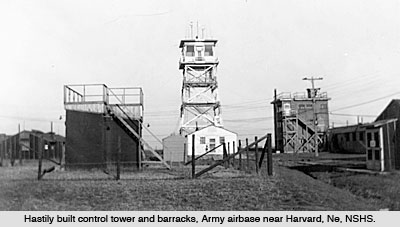
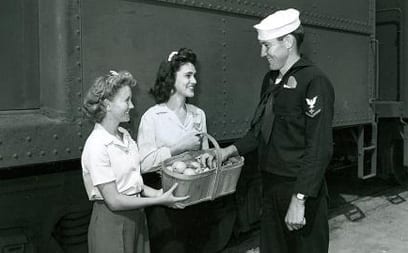
Military Experience
Nebraska’s Sacrifice
During World War II, 30,053 people from Nebraska enlisted or were drafted into the United States armed forces. Of this 30,053 people 2,976 did not return.
Enlistment
On February 17, 1943, Louie Pieper and his twin, Henry, applied for enlistment at the U.S. Navy recruiting sub-station in Lincoln, Nebraska. Their parents had to consent since the boys were under 18, which they did two days later. On February 27, they reported to the Navy Recruiting Station in Omaha, Nebraska. They entered the U.S. Naval Reserves as apprentice seamen. On March 7, they were told to report to Omaha for active duty and transferred to the U.S. Naval Training Station in Great Lakes, Illinois.
Radio School
On May 27, 1943, the twins entered Radioman School at the University of Chicago. At radio school, they learned Morse code and the United States Navy communicational and radio theory. Along with 162 other servicemembers, the Pieper brothers graduated from Radioman School on November 5, 1943.
Once in service, they were initially separated, as per U.S. Navy policy, but they appealed and made a special request. They wrote a letter to their father stating that they were separated, asking for his sign-off to be stationed together. He wrote to their commanding officer, declaring, “My sons came into this world together, and they should have the right to fight and die together.” Their commanding officer relented, and they were allowed to serve together.
LST-523
On January 7, 1944, Henry and Louie Pieper received orders to report to the Supervisor of Shipbuilding at the U.S. Navy Jeffersonville Boat & Machine Co. in Jeffersonville, Indiana. On January 25, they departed Jeffersonville aboard Landing Ship Tank (LST) 523, bound for New Orleans, Louisiana. After traveling down the Ohio and Mississippi Rivers, they arrived on February 2, and on February 3, their LST was commissioned. From there, LST-523 joined a large convoy of ships to cross the Atlantic Ocean.
First Two Voyages
When the Normandy campaign began June 6, 1944, LST-523, nicknamed Stardust by her captain, made the first of three round trips from England to Normandy’s beaches. On its first trip, LST-523 could not approach Omaha Beach because of the debris and swells. They unloaded the men and equipment into smaller boats and returned to England with 175 Allied casualties. Both sides of the LST were lined with cots that could fold up and down, depending on the situation. The cots could be raised to carry equipment and put down when caring for the wounded on the return trip. On the second trip, LST-523 reached Utah Beach and unloaded the men. They loaded about 200 Allied casualties and some German POWs and returned to England.
Final Voyage
On June 18, 1944, LST-523 left England in the early afternoon loaded with men, vehicles, equipment, and explosives and proceeded towards Utah Beach for its third trip. Weather in the English Channel is very unpredictable, and a gale-force wind erupted unexpectedly in the early hours of June 19. LST-523, one LST in a line of three, arrived off Normandy’s coast in the middle of that violent storm. LST-523 was trailing LST-27, but as they moved towards shore, LST-27‘s anchor got caught in some wreckage, and she signaled LST-523 forward to take her place in the formation. A little after 1:00 p.m., LST-523 started towards the beach and hit an underwater magnetic mine. The explosion occurred in the center of the ship. Many of the men were in the mess line and were killed instantly. Survivors were rescued by 20 smaller craft that appeared on the scene.
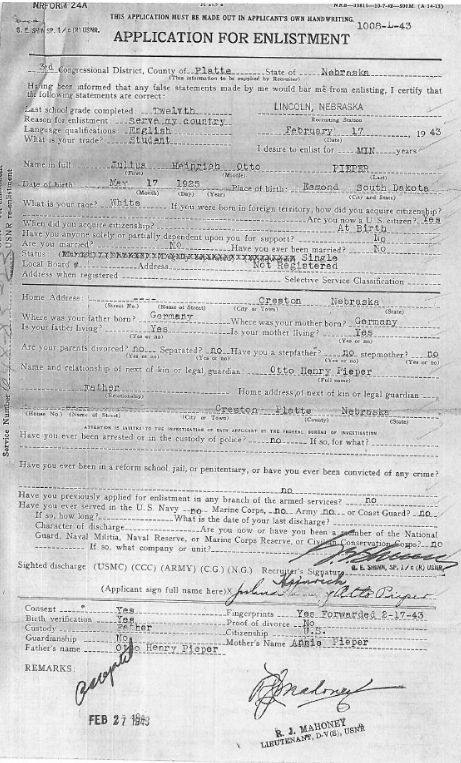
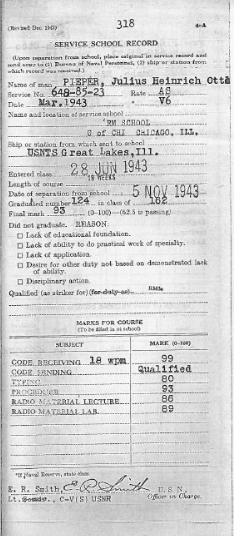
Eulogy
Otto and Anna Pieper received a letter from the brothers only two days before their deaths stating, “Do not worry about us. We are together.”
Louie Pieper and his brother, Henry, were only 19 years old when they died on LST-523.
A memorial service was held at St. Peter’s Lutheran Church in Creston, Nebraska, on July 30, 1944. Over 300 people attended. They were the first Creston youths to die in World War II, and the Pieper Post, Number 306 of the American Legion in Creston, was named in their honor. They were cited for bravery, and each received the Victory Medal and the Purple Heart after their deaths.
Louie’s remains were recovered and buried in plot E, row 15, grave 39 at Normandy American Cemetery. Initially, Henry’s remains were not recovered, and his name was listed on the Tablets of the Missing at Normandy American Cemetery. In September 1961, salvage divers recovered remains in what was the radio room of LST-523. The remains were interred in Ardennes American Cemetery in Neupré, Belgium, designated as Unknown X-9352.
In 2017, the Defense POW/MIA Accounting Agency (DPAA) used bone length, dental records, location of the remains, and personal items to identify Henry Pieper. His family requested that the brothers be buried together. On June 19, 2018, both brothers were laid to rest next to each other with full military honors at Normandy American Cemetery.
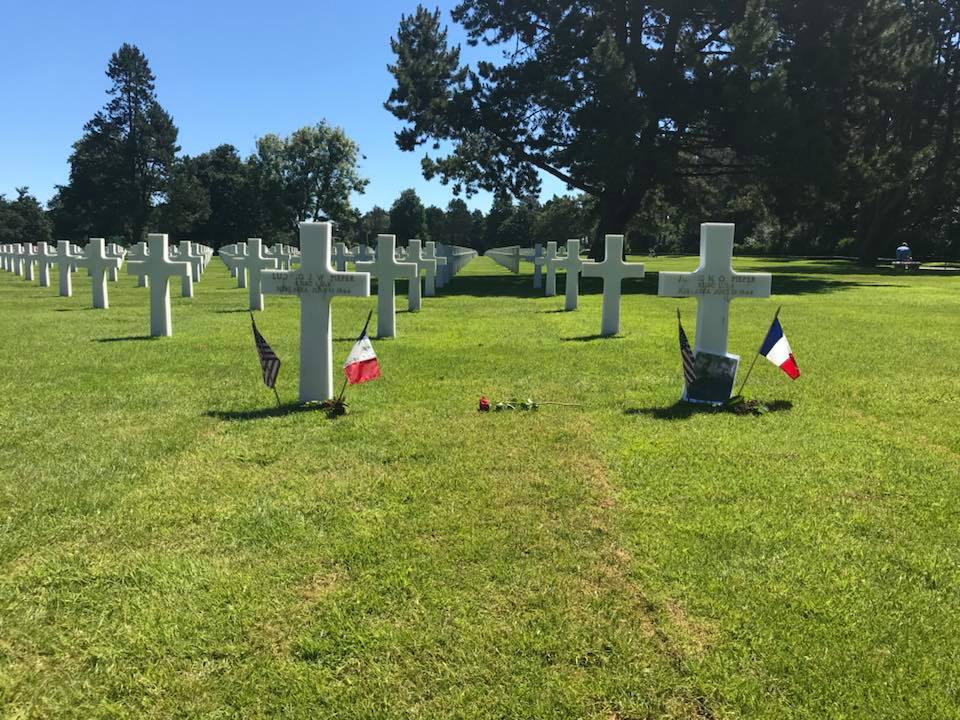
Reflection
The Normandy Sacrifice for Freedom: Student & Teacher Institute has changed my life in more ways than I can count. I started this project with a vague perspective on World War II and came out of it with more facts and statistics than I know what to do with! However, this program has taught me so much more than facts about World War II. It has shown me at least a glimmer of what it was like for America’s sons storming the beaches on D-Day, as well as the hardship the families behind those very young soldiers endured. Before I started this program, I took so many things for granted, one of them being the freedoms we have in this country. I never once stopped to think about the sons, fathers, mothers, and daughters that made our country this way. I am so glad that this program has opened my eyes to those truths, and I hope that they stay with me forever.
We had several months of extensive World War II research during this program, topped off with trips to Washington D.C. and France for two weeks. While traveling in D.C. and France, we visited several extraordinary museums and locations related to World War II. Every stop opened my eyes up to a new part of World War II. Still, it was not until I stepped into the Normandy American Cemetery and found Ludwig’s grave that I began to understand what the sacrifice truly was. There were thousands of graves in that one cemetery alone. Men and women who had given their lives to free others. Henry & Louie showed me the true definition of sacrifice: being willing to give up anything and everything to be part of a truly great cause and doing it to help others, not to be treated as a hero. These people gave their lives for us, and now it is time to tell their stories.
Bibliography
Primary Sources
[A control tower and barracks at the U.S. Army airbase near Harvard, Nebraska]. Photograph. Nebraska State Historical Society. livinghistoryfarm.org/farminginthe40s/life_09.html.
[Enlisted African American sailors working on the Naval Ammunition Depot assembly line in Hastings, Nebraska]. Photograph. 1944. National Archives and Records Administration (283499). nebraskastudies.org/assets/images/0809_0601afam2.original.jpg.
Heinrich Julius Otto Pieper. Evangelical Lutheran Church in America Records, 1781-1969. Digital images. ancestry.com.
Julius H. O. Pieper Enlistment File. National Personnel Records Center, National Archives and Records Administration, St. Louis.
Julius H. O. Pieper Individual Deceased Personnel File. Department of the Army.
Julius Henrich O. Pieper. World War II Navy Muster Rolls, 1938-1949. Digital images. ancestry.com.
Lawrence, Mary Ann. Telephone interview with author. June 1, 2015.
Lawrence, Susan. Telephone interview with author. June 1, 2015.
Nebraska. Platte County. 1930 U.S. Federal Census. Digital images. ancestry.com.
Nebraska. Platte County. 1940 U.S. Federal Census. Digital images. ancestry.com.
Pieper Family Photographs. 1920s-1940s. Courtesy of Mary Ann Lawrence and Susan Lawrence.
[Volunteers from the North Platte canteen offer treats to a U.S. sailor during World War II]. Photograph. Lincoln County Museum. lincolncountymuseum.org/1-the-story-begins
Secondary Sources
Beardsley, Eleanor. “How A High Schooler Helped Reunite Twins 74 Years After Their World War II Deaths.” National Public Radio, July 4, 2018. www.npr.org/2018/07/04/624354851/how-a-high-schooler-helped-reunite-twins-74-years-after-their-world-war-ii-death.
Cigainero, Jake. “A high school project reunites twin brothers 74 years after the died on a ship in Normandy. The World, Public Radio International. August 15, 2018. www.pri.org/stories/2018-08-15/high-school-project-reunites-twin-brothers-74-years-after-they-died-ship-normandy.
Curry, M. Creston Q125 History 1890 – 2015. Creston: Creston Celebrations, 2014.
Ellyson, Tyler. “Young Blood Keeps Creston Alive.” Columbus Telegram, July 30, 2015. columbustelegram.com/news/local/young-blood-keeps-creston-alive/article_689beaa6-847e-5e63-b185-826f308b98fa.html.
“Julius H. O. Pieper.” American Battle Monuments Commission. Accessed March 5, 2021. www.abmc.gov/decedent-search/pieper%3Djulius.
Kimble, James J. Prairie Forge: The Extraordinary Story of the Nebraska Scrap Metal Drive of World War II. Board of Lincoln: Regents of the U of Nebraska, 2014.
Liewer, Steve. “Brothers reunited: Nebraska teen’s research contributed to this week’s reburial of twin at Normandy.” Omaha World-Herald, June 20, 2018. omaha.com/local/brothers-reunited-nebraska-teens-research-contributed-to-this-weeks-reburial-of-twin-at-normandy/article_2625546c-42a4-5b13-8cc0-d8a97ffa5d7f.html.
Martys, Shirley Burhn. “RDM2 Julius Heinrich Otto “Henry” Pieper.” Find a Grave Updated November 25, 2009. Accessed March 5, 2021. www.findagrave.com/memorial/44795837/julius-heinrich_otto-pieper.
Meyer, Alex. Honored Pre WWII Heroes of the Logan-Pebble-Maple Meridian Creeks Locale: A Compilation of Patriotic & Community Oriented Service. Lincoln: Cornerstone Printing & Marketing, 2013.
Miller, Ted and Carole. “Radioman’s Mate Second Class Julius H. O. Pieper And Radioman’s Mate Second Class Ludwig J. W. Pieper.” History of Platte County. Accessed February 12, 2015. www.usgennet.org/usa/ne/topic/resources/OLLibrary/Platte/pages/heros/hpcn0184.htm#jholjwpieper.
The North Platte Canteen. Online Exhibit. Lincoln County Historical Museum. www.lincolncountymuseum.org/the-north-platte-canteen1.
Reinhardt, Claudia and Bill Ganzel. “Military Bases in Rural Areas during World War II.” Wessels Living History Farm. Accessed March 5, 2021. www.livinghistoryfarm.org/farminginthe40s/life_09.html.
Slavin, Erik. “Death at Sea separated these twins 74 years ago. Now They’re back together.” Stars and Stripes, June 20, 2018. www.stripes.com/news/europe/death-at-sea-separated-these-twins-74-years-ago-now-they-re-back-together-1.533759.
Trouillard, Stephanie. “U.S. twins killed together during World War II re-united in Normandy burial.” France 24, June 20, 2018. www.france24.com/en/20180620-american-twins-brothers-pieper-julius-louie-world-war-normandy-colleville-cemetery.

